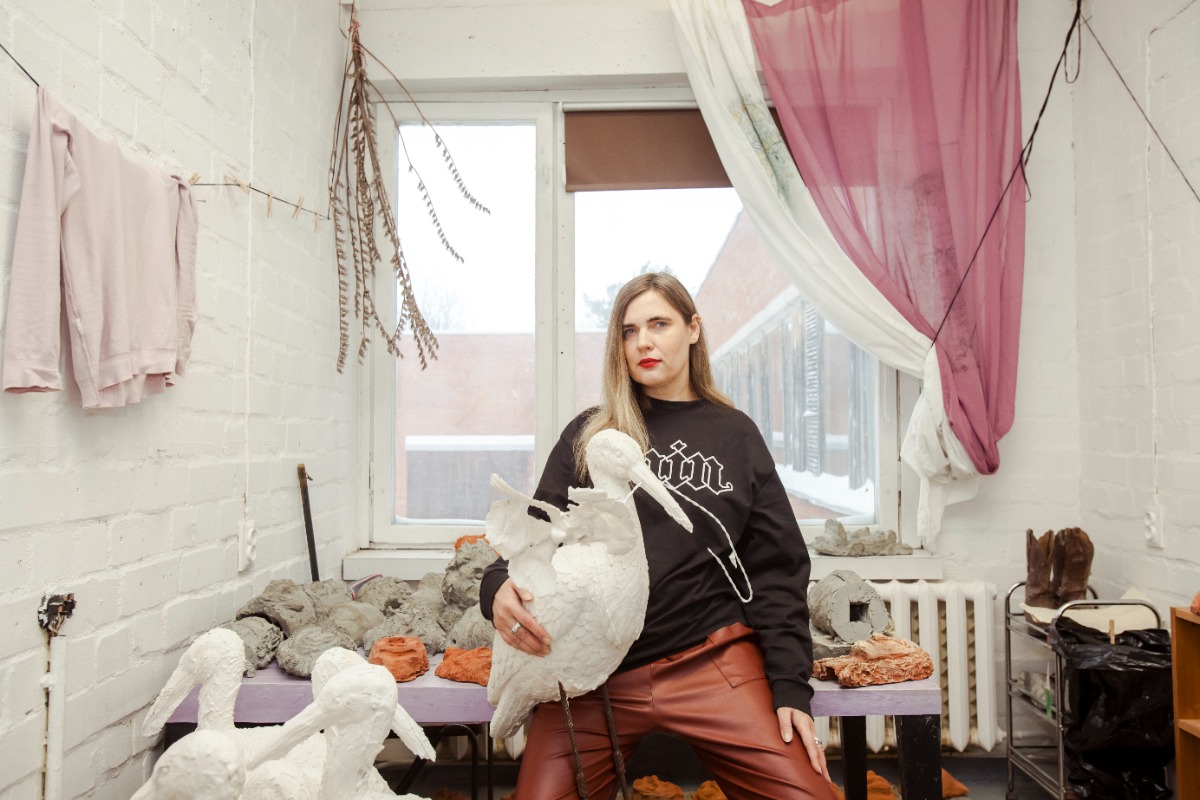
The moment of falling
An interview with sculptor Edith Karlson, who will represent Estonia at the 60th Venice Biennale
In just three months, the world's art lovers will turn their gaze to the contemporary art presentations of the 60th International Venice Biennale. This year Estonia will be participating in the Biennale for the 14th time, and with the aid of an international selection committee, have chosen sculptor Edith Karlson (1983) to represent their country.
Karlson will develop the narrative of her artwork through the method of worldbuilding, which will take place in a church, (Chiesa di Santa Maria delle Penitenti), in Venice. Forming an indivisible whole, the sacred space and sculptural objects will together provide the viewer with a fully inclusive experience. This experience, which petitions the absurdity of the contemporary world, will be translated to humans (beings endowed with reason and consciousness) by characters from the animal kingdom. Animals have always been at the centre of Karlson’s sculptural work, both allegorically and symbolically. In the Venice exhibition, they will be joined by humanistic impersonations.
In 2015 Karlson participated in producing British artist Sarah Lucas' solo exhibition I Scream Daddio in the British pavilion at the Venice Biennale. Just short of ten years later, Karlson is returning to the biennale – but this time, showing her own work and proudly representing her own country. When asked what it was from collaborating with the prominent Sarah Lucas that inspired her the most, Edith replies: “I love her very much. She’s a cool lady. She handles things with a fun and easygoing attitude, which is inspiring. There is no stress in doing this kind of thing [producing a pavilion at the Venice Biennale]. This is perhaps the nicest thing that I remember. You just do what you do and enjoy what you are doing!”
In her exhibition titled Hora Lupi, Karlson explores the idea of the moment of falling. The moment when the fall has already begun, the fall itself is inevitable. The moment is brief, yet many questions linger – should one just give up, or is there still a fighting chance?
Edith Karlson. Hora Lupi, 2024. Works in progress. Photo: Anu Vahtra / Estonian Centre for Contemporary Art
First and foremost, I would like to congratulate you on your participation in the Venice Biennale, and also wish you luck in getting everything ready, as the date of the event is rapidly approaching…
Thank you! And as for the second part – no comment… [Wryly chuckles]
What was your initial reaction when you found out you were chosen for Venice?
In 2022, the Estonian Centre for Contemporary Art issued an open call for artists to represent Estonia at the biennale. Artists were required to submit a proposal introducing the main focus of their previous works and expressing and explaining the motivation behind the idea to collaborate on the national pavilion's project at the biennale. The seven selected artists interacted directly with an international jury, discussing their portfolios and such. I wasn’t quite comfortable with this because I’m not a good speaker, especially about my work.
This is one reason why I am an artist – I struggle with vocalizing myself and can feel very insecure. It went well, but I was not confident that I would be chosen since I knew the other artists and their abilities. So, I was very surprised, and obviously happy, too, but the sheer astonishment was a bit greater than the happiness.
Edith Karlson. Vox Populi, 2016. Photo: Anu Vahtra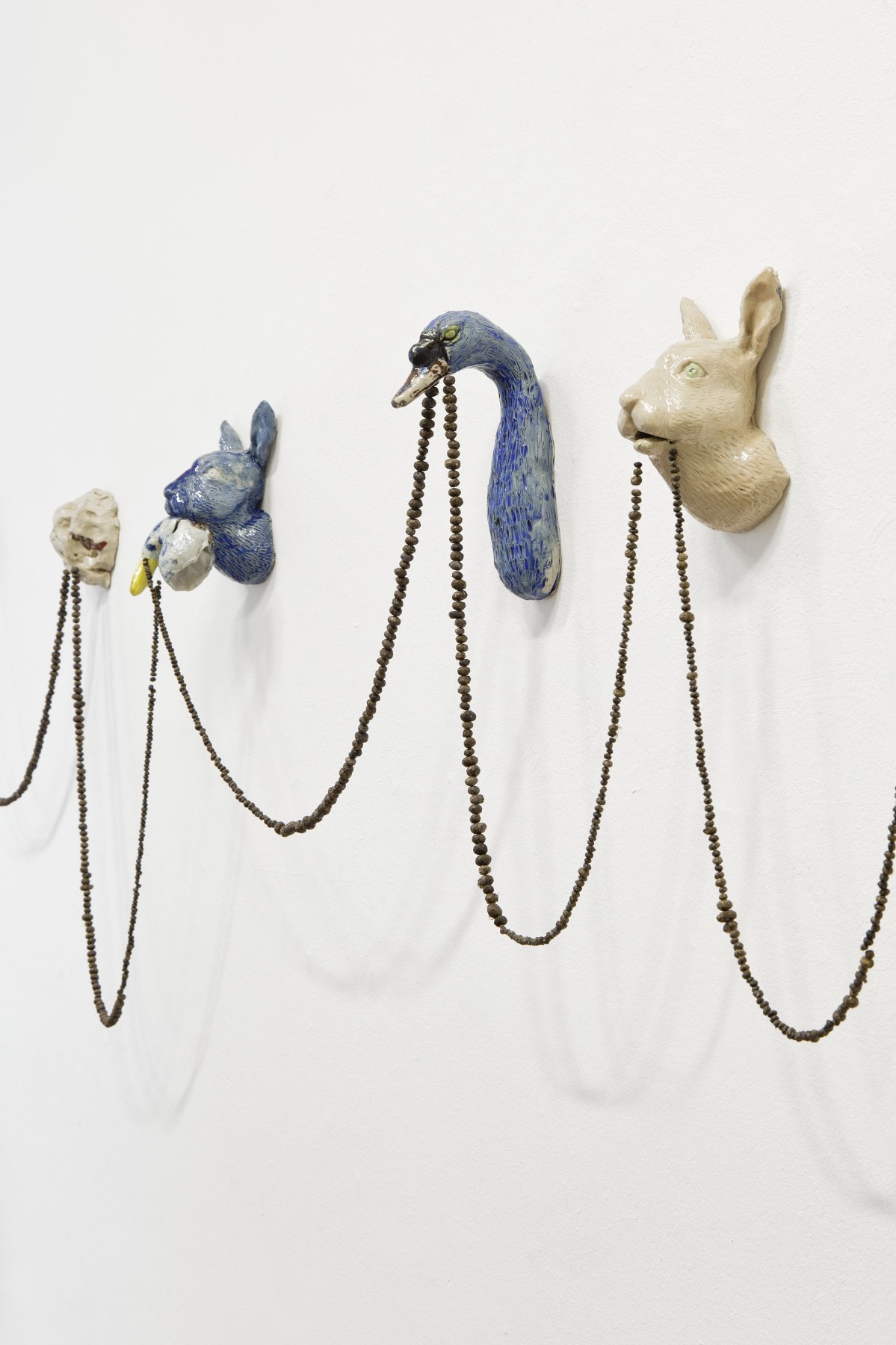
Well, luckily, I’m not here to judge or rate your work – I just want to find out more about it! As I explored your oeuvre, your use of animals to represent different ideas made me think of George Orwell. Would you say that you’re employing an Orwellian approach by using animals as symbolic representations?
I think this analogy is fair enough. However, I must honestly say that when I work, I don’t consciously draw parallels. I just create what I feel. I just do what I do, and using animals is a way I want to express something about humans – portraying human actions, behaviours, and those weird and unfortunate things that people do.
Moving on to the focal point of your work – does it primarily revolve around socio-political or geopolitical events, or do you delve into more personal issues? Or perhaps your work stands in the intersection between the two?
It’s a mix of everything. Personally, I wouldn’t be capable of creating art solely to mirror societal or political issues. It would be boring for me just to reflect. I absorb everything around me – from political and societal situations to personal experiences. I’m not pointing out specific problems but blending them with my own feelings about various situations.
Do you reflect in a satirical or critical way about your chosen topics, or is it more explorative and contemplative? Orwell’s style was quite satirical…
I would say it’s a mix of feelings, with irony playing a significant role, especially self-irony. Self-irony is crucial, as people often lack the ability to laugh about themselves and reflect on their own ridiculousness. But it is important to me to balance irony with warmth, sympathy, and even a touch of romanticism. In my opinion, very ironic people are usually very smart, highly intelligent people – and the more intelligent they are, the more ironic they are. But if there’s too much of this, it can be very annoying because it kills some feelings. I’m warm, sincere, and even somehow romantic, but I am also super ironic, especially about myself and towards whatever things. First of all, I find myself laughing more at myself than at others.
Edith Karlson. Installation at Kumu Art Museum, 2019. Photo: Hedi Jaansoo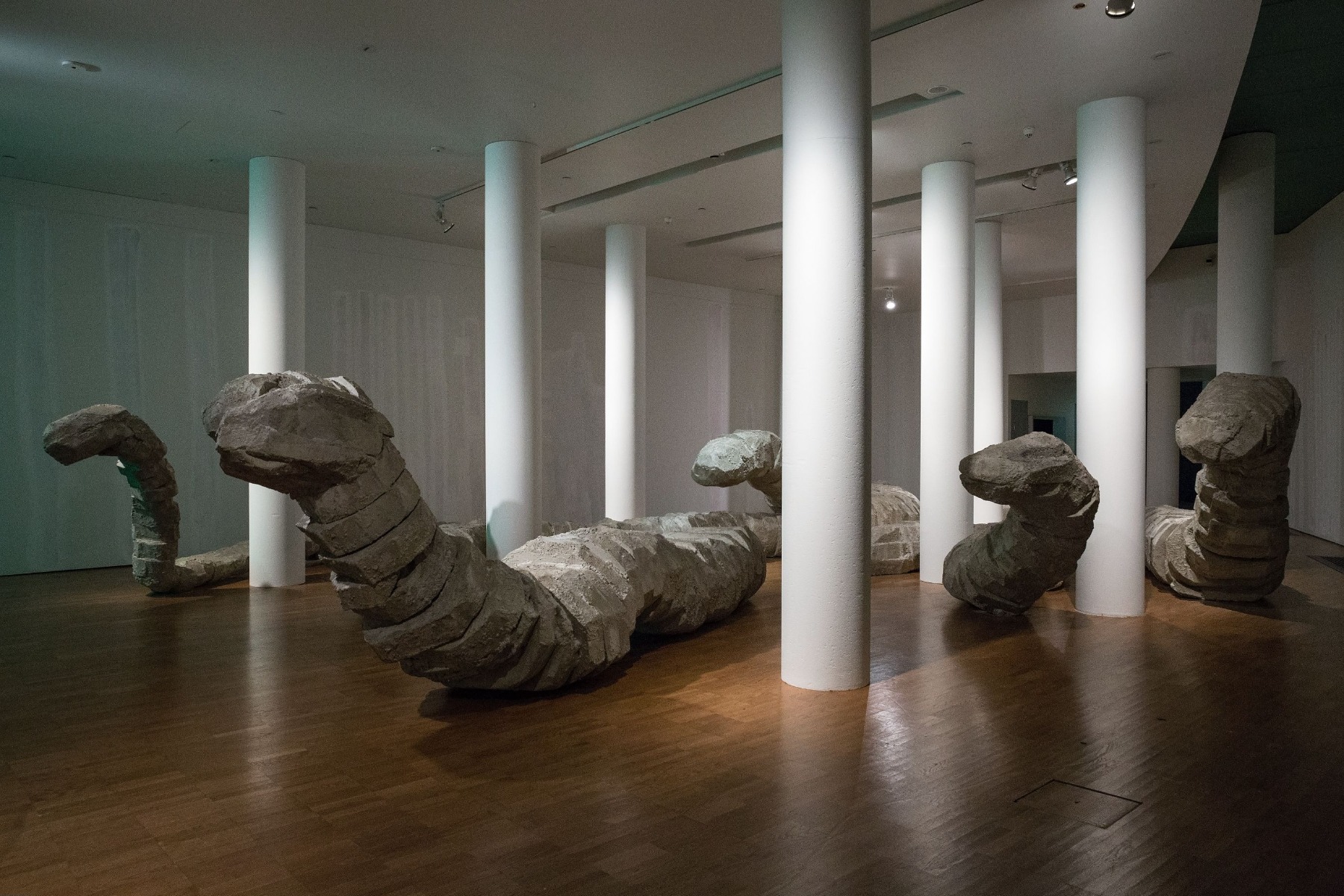
Why is the world of animals the foundation of your sculptural work? Have you always been connected to nature? Do you have wildlife studies in your background? Perhaps you collect skulls or taxidermy, or you’re a huge fan of “cabinets of curiosities” or natural history museums…?
It’s rooted in my childhood. I’ve been a huge, huge animal lover ever since I can remember. I embraced all creatures except worms and snakes – I was quite phobic of them. But I overcame that and now I make snakes, like hundreds of snakes, with my own hands, and I love them! My interest in animals stems from watching nature shows on TV with my grandmother, who by then had access to a German TV channel, as well as exploring the outdoors.
I remember a peculiar incident – I had found a dead rat. My curiosity led me to the kitchen, where I grabbed a butter knife – specifically not a sharp one. My intention was not to cause harm – the rat was already dead – but rather to explore the creature’s anatomy out of sheer fascination. This curiosity has always extended beyond the physical aspects of animals. I find myself intrigued by the whole bouquet, I mean, their familial structures, lifestyles, and even their psychology.
Nowadays, I own a countryside house in the woods, where walking along animal paths has become my favourite thing. Particularly enchanting are the early spring and late autumn seasons, when the absence of leaves allows me to see the intricate network of animal “highways”. These paths, utilised by generations of animals, can be seen as the original highways of the natural world. During these walks, I often stumble upon fascinating remnants of the animal kingdom – bones, leftovers, and even deer poop. Yes, deer poop. I collect them to incorporate them into some of my creative works.
At Edith Karlson's studio. Photo: Alana Proosa
I must ask about your avoidance of depicting the human body. What holds you back from humans? What is your relationship with the human body?
This is changing now. My first venture into depicting the human body was a chandelier I called Doomsday, which I made of my own body parts after giving birth to my kid. The experience of childbirth opened my eyes to the theme of the human body and womanhood. For me, the experience of becoming a mother was so overwhelming and hard because I had an extremely difficult labour. Also, when my son was young, he literally didn’t sleep, so I didn’t get any sleep at all for three years. I called the piece Doomsday, which is a character in Superman comics. This character possesses a unique ability: attempting to kill him with a weapon only makes him stronger. The more you try to harm him, the more powerful he becomes.
In a bizarre twist, I found myself collecting my own body parts, combining them, and witnessing the creation of a monstrous version of myself.
Edith Karlson. Hora Lupi, 2024. Works in progress. Photo: Anu Vahtra / Estonian Centre for Contemporary Art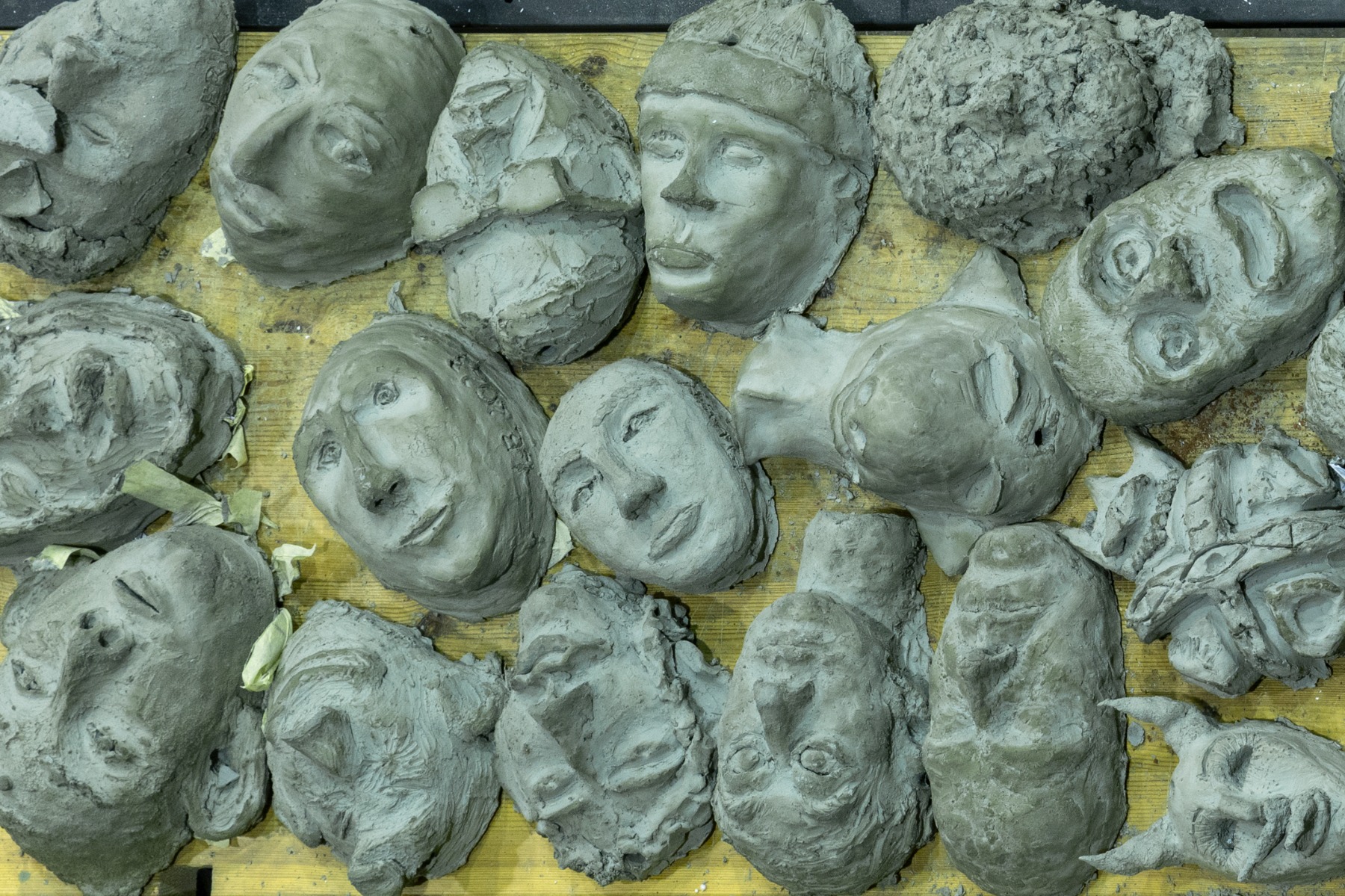
I read that you organised a clay self-portrait workshop for the Biennale installation. Can you tell me more about this?
About 200 people have come to me and make their portraits. I love this project so much! It actually started with my exhibition Return to Innocence, at the Contemporary Art Museum of Estonia. This exhibition was about my work mixed up with artifacts from the museum. The curator introduced me to the clay portraits of St. John’s Church [Jaani kirik] in Tartu. I saw the pictures of the portraits, and something clicked for me. I just loved them so much – I was enamored with the colour of the clay, and I decided that I want to include these portraits in my work. So I began creating portraits myself. I started with five, but then I sat down and thought, this is too boring… And I really want to create a lot more. I then delved further into the subject and researched St. John’s Church. I found out that there were thousands and thousands of these portraits. What fascinated me was the absence of hierarchy in these portraits – queens, kings, slaves, children, women, you name it – all on the same level. It excited me, discovering a unique hierarchy system from a distant past.
At Edith Karlson's studio. Photo: Alana Proosa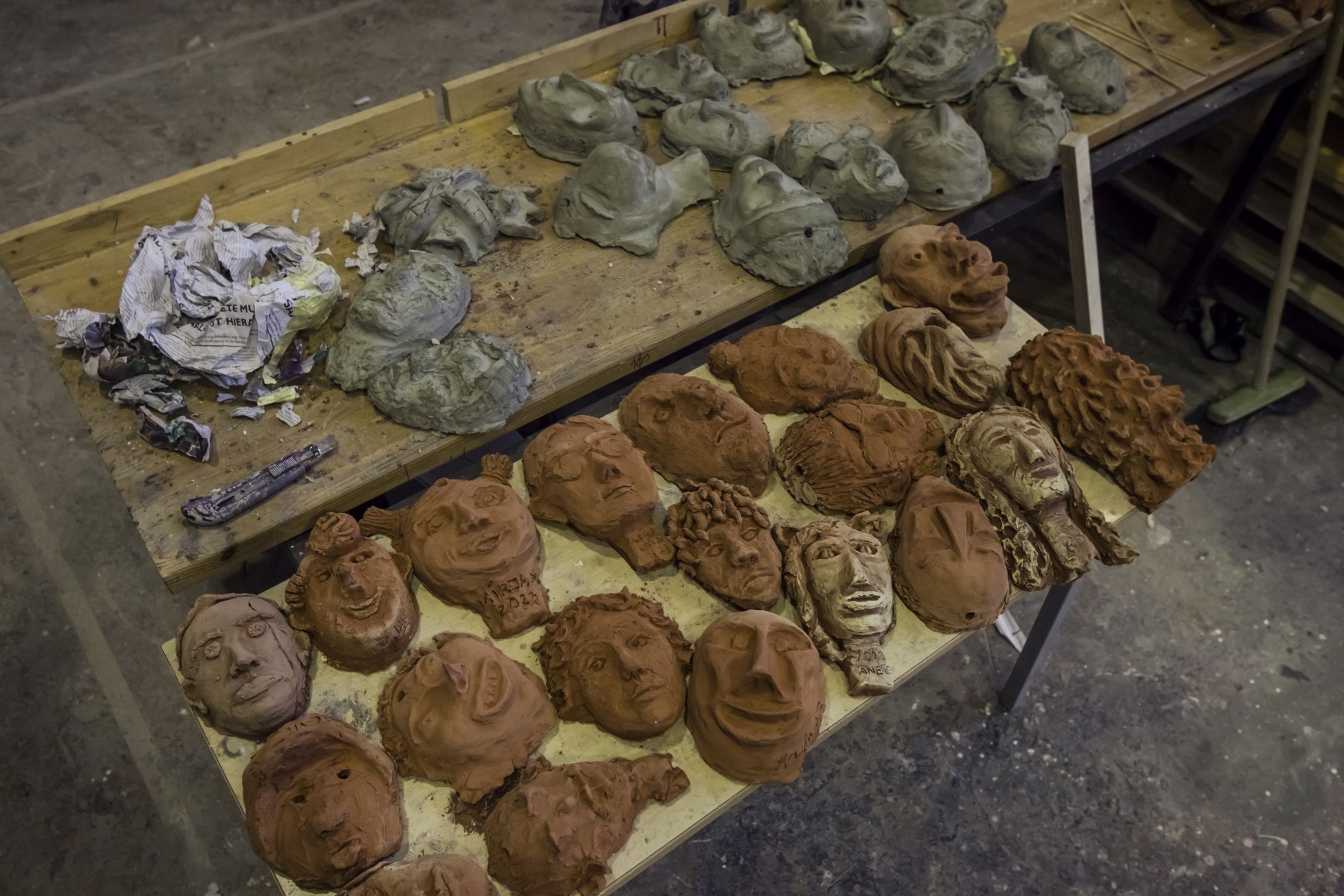
It was also when the Covid lockdowns had just ended. Literally, like two weeks before; all the people could finally come out of their houses again. They had spent months having this very special alone-time, reflecting on themselves and doing things they hadn’t had time to do before. It was such good timing!
At first, I asked just a couple of my friends to come and have their portraits done. I noticed something – people who lack sculpting skills initially felt quite insecure, but when I assured them that everything will be fine regardless of the outcome, they started to simply let go and create freely. As a result, and I’m not kidding, every portrait looked exactly like their authors! I don’t mean in terms of physical appearance but in terms of character and personality.
Then I organised a course at the Art Academy. Before students started to do calculated, measured self-portraits, I asked them to do a quick one – just without thinking. And again, the first ones that came out just like this were really like the personalities of these people. Now that I have had more than 200 people go through this, I haven’t changed my mind. It works! And it’s amazing!
Edith Karlson. Hora Lupi, 2024. Works in progress. Photo: Anu Vahtra / Estonian Centre for Contemporary Art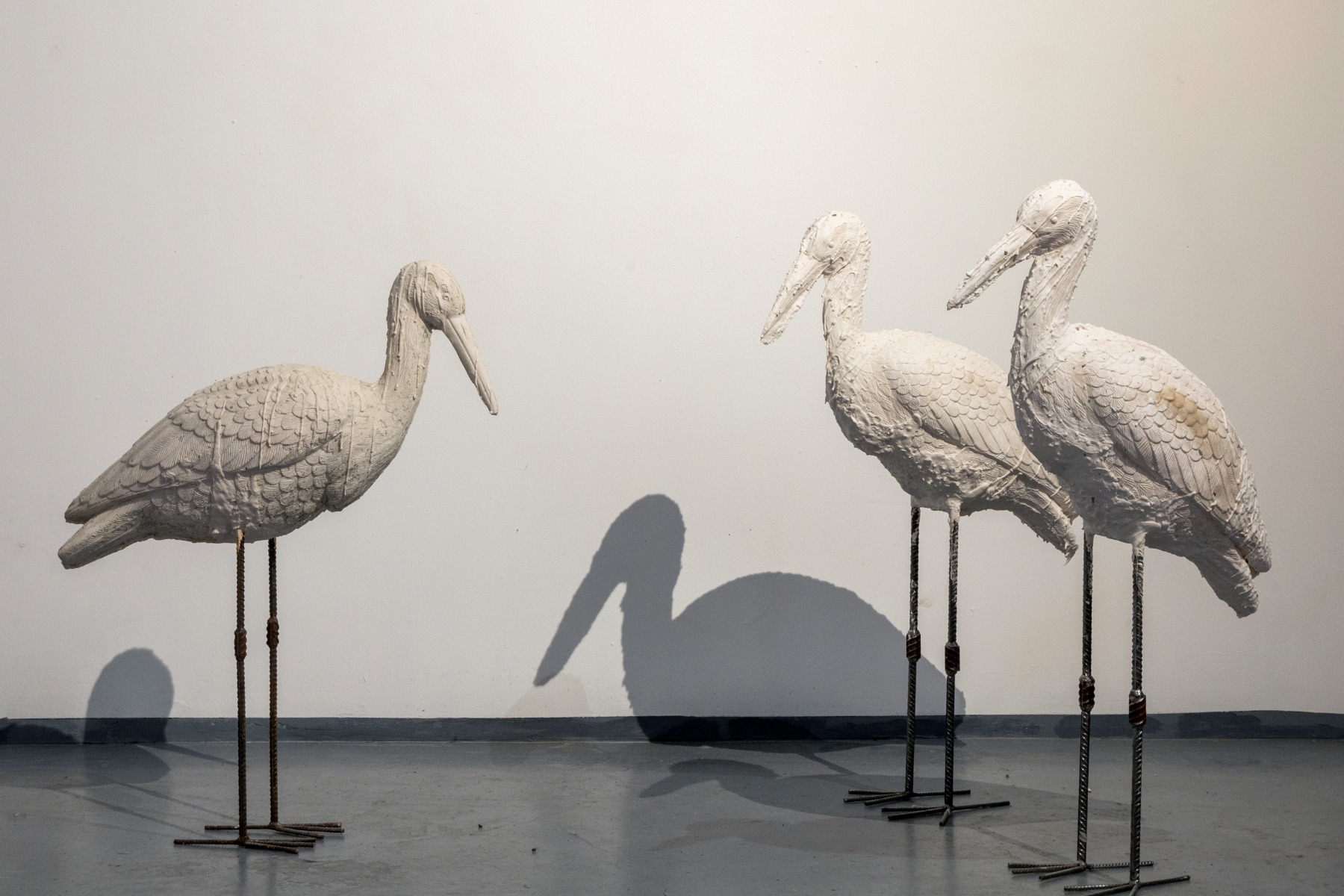
What is your vision regarding integrating these portraits into your overall installation?
This year, Estonia’s representation will take place in an old Catholic church. I was thinking of putting these clay portraits on the cornice – like they used to be in St. John’s Church in Tartu, but right now I am hesitating to do so. I love those portraits so much that I’m afraid they will be too high and far away to be seen up there – it’s important that people can look at them. Honestly, now I am trying to figure out how to place them. I have loads of other things to be exhibited there, and these portraits are going to be a little bit like the audience looking at all this stuff.
Can you sketch out what else will be in your presentation?
There are going to be three centrepieces. One is truly monumental – a composition with figures over five metres high. Additionally, there will be three weeping women. Here [begins showing works via the Zoom camera] you can see my grandmother’s hands, and she will also have hair. I refer to this piece as “the mourning” or “sad” woman. Then come the storks…
However, this is just a small glimpse of the work. There will also be mythological creatures which will be challenging to discern whether they are animals or humans.
You’ve said that the focal point of your installation in Venice will be this feeling of falling. Is there any connection between falling and a religious context, considering that the exhibition will take place in a church and that you’ve drawn inspiration from St. John’s Church in Tartu? How do these elements link together?
It’s definitely linked to the church because I am using the space of the church. And I’m not using this space just as “a space” but as a sacred church space. But, like I said, I’m not the kind of artist who points out things; I prefer to hint. Hints, hints, hints... I’m very ambivalent when it comes to this question because, personally, I come from a family that has been atheist for generations, so I don’t have a close connection to religion. Still, I am a “believer” because I do believe in things and I respect everyone who has chosen to believe in something.
Edith Karlson. Hora Lupi, 2024. Works in progress. Photo: Anu Vahtra / Estonian Centre for Contemporary Art
Have you tailored your work to engage with the diverse international audience that attends the Biennale?
No. You know, I’m a very cut-off person somehow. I will show you… [points the camera to the snow-covered woods outside her window]. My life is literally like this – I am in the woods. My studio is in Tallinn; it’s the sculpture department. I studied there as well, actually. Originally built for creating monumental sculptures, it still echoes with the work of old-school sculptors who crafted those gigantic Soviet-era statues. The space is full of sculpting energy.
When I finished school, I found myself contemplating how the art world operates. As an artist, I wondered about the best approach. Should I attend openings, engage with people, and navigate such events? I quickly realised that my nature wasn’t aligned with the conventional way of socialising at art openings. While I do attend openings when my friends are showcasing their work, it’s not my preferred way to spend time. It’s not arrogance or anything like that. It’s about the fact that all my time goes to doing my work, and as I have a child, in the evenings I go home to see my child. That’s why I don’t have time to consume art. But if I hear or see something that is good, it moves me a lot and I’m very grateful for that.
I’m privileged to be able to focus solely on my work without distractions. While I have attended openings in Venice for friends, that doesn’t dictate my approach. I work on what makes me happy – it is an essential part of my method. I keep myself mentally fit…also to avoid boredom. Sculpting can be emotional – some pieces even bring me to tears. It’s a balance between enjoyment and deep emotional engagement.
At Edith Karlson's studio. Photo: Alana Proosa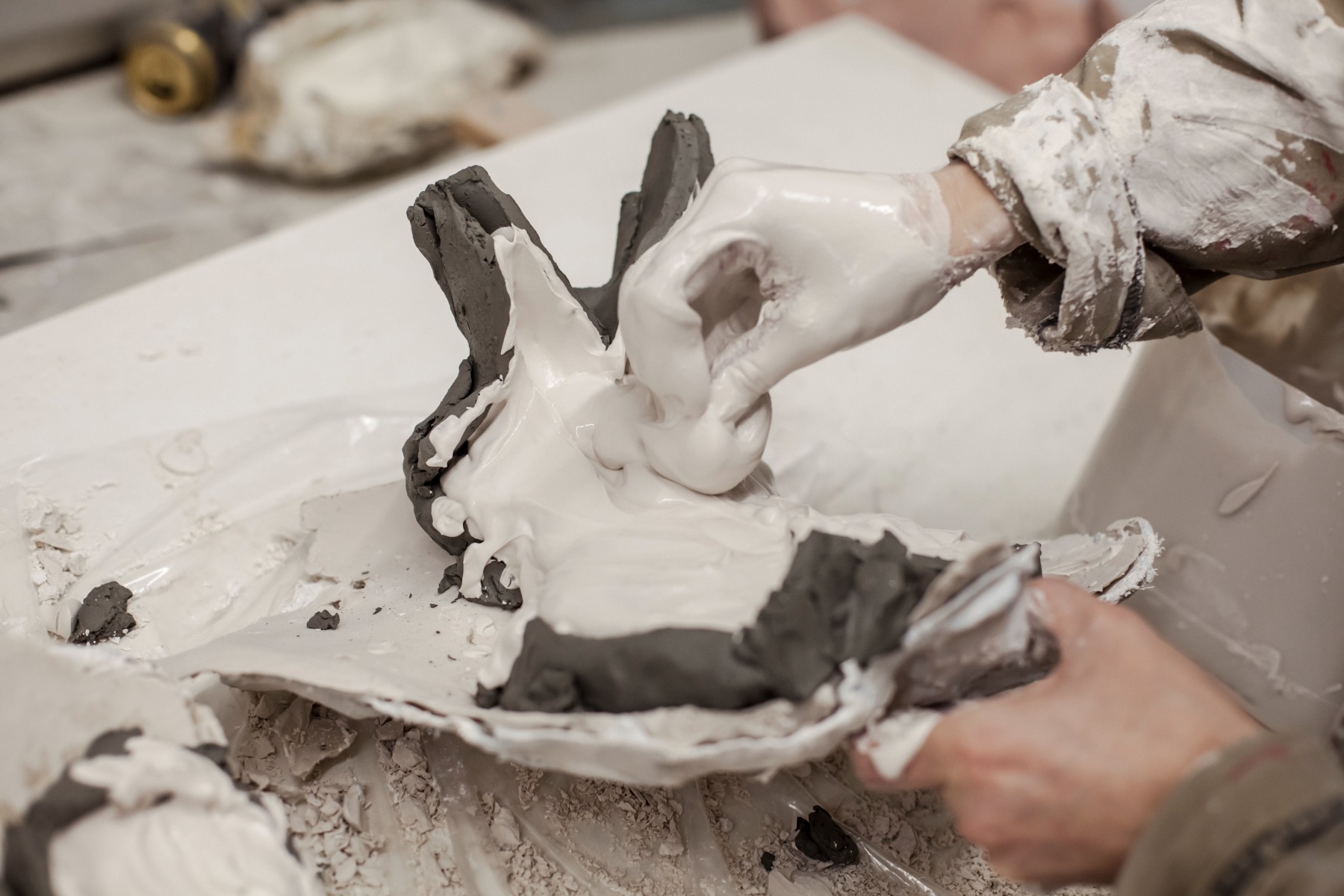
Then let’s stick with your own microcosm and delve into your studio… Can we have a sneak peek into it? What does is smell like in there? Is there a thick layer of dust? How about music? Or do you prefer to work in silence?
I will start with the music… I’m a radio listener. I play with music and sounds all the time. Sometimes I love to listen to those radio shows where people call in; there’s a specific show in Estonia called Vox Populi. I even named a series of my work Vox Populi [2016, an installation of more than 100 animal figures and rabbit droppings – Ed.] because I was only listening to this at the time. They tackle different themes on a daily basis, such as opinions on the price of electricity, and callers from all around Estonia express their often-times negative views. Sometimes I get tired of the hard life of the Estonian people and I want to get away from it – so I turn on NTS Radio, which broadcasts from London.
And talking about smells…you can definitely smell clay here – it’s all over the place! As well the dust from the clay. There are also some chemical smells because I have been using a lot of polyester resins. So, the smell of clay is mixed up with this poisonous smell, but I am so used to it that I don’t even notice it anymore. Right now, when working with those portraits, I am using the ceramic kiln a lot, which is a pretty important aspect. I’m using very robust clay – it’s very earthy, the same clay that bricks are made of, actually. When it’s fired in the kiln, all these weird smells emanate because there are centuries-old micro-substances in it that give a very specific smell to the building. Although it belongs to the Art Academy, which no longer operates here, students still use the space. In this environment, you have the freedom to do what you want because it’s an old building and you don’t have to clean up. Being a sculptor is very messy, dusty and dirty work. This is a fact.
A half of the building belongs to the Monumental Association, to which I also belong. So, half of the rooms belong to skillful old school sculptors, which I love. And the system works like this – if you have a room here, then you can use it until the day you die. You can’t get there very easily. I love my studio a lot!
At Edith Karlson's studio. Photo: Alana Proosa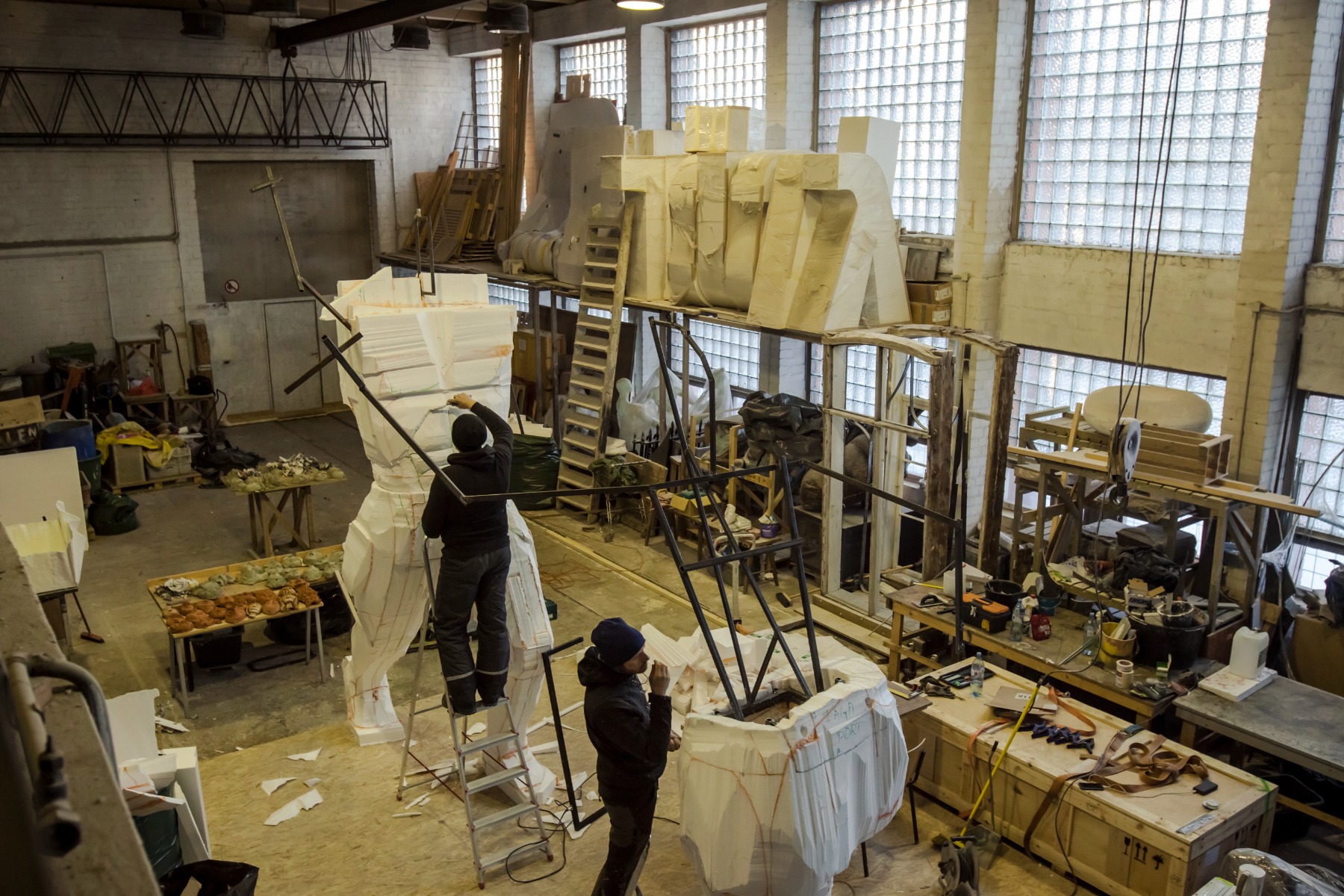
Talking about the process of sculpting, do you typically plan your sculptures in detail, or do you prefer a more spontaneous approach?
Well, I am not the type of artist who sketches a lot. At some point, of course, I have to do sketches because if I go big or large, then it means more technical thinking – then I have to sketch them up. But loads of work has come my way that I just somehow start doing. I think it’s like an unbreakable chain – once I start, everything expands.
It’s like a never-ending process. Sometimes I really have no idea where it will end, but again, if the projects are very big – for example, like the Venice pavilion – then I can’t afford this luxury.
How do you emotionally connect with your sculptures? Or do you even?
I do, I do. When I start doing the work, there is a feeling that I want to put inside of it. And then, at some point, the working process becomes very physical and I don’t think about the meaning of it because I am so focused on just finishing the work. At that moment, I am a worker who is just building something. I don’t even remember what I’m doing – all I know is that I have to finish this. When the process ends and the pieces or sculptures are finished, it usually takes me a long time to look at them and understand what I have done. I’ve noticed that it takes more than a year for me to be able to look at them objectively and say – okay, this has been pretty okay work that I’ve done.
At Edith Karlson's studio. Photo: Alana Proosa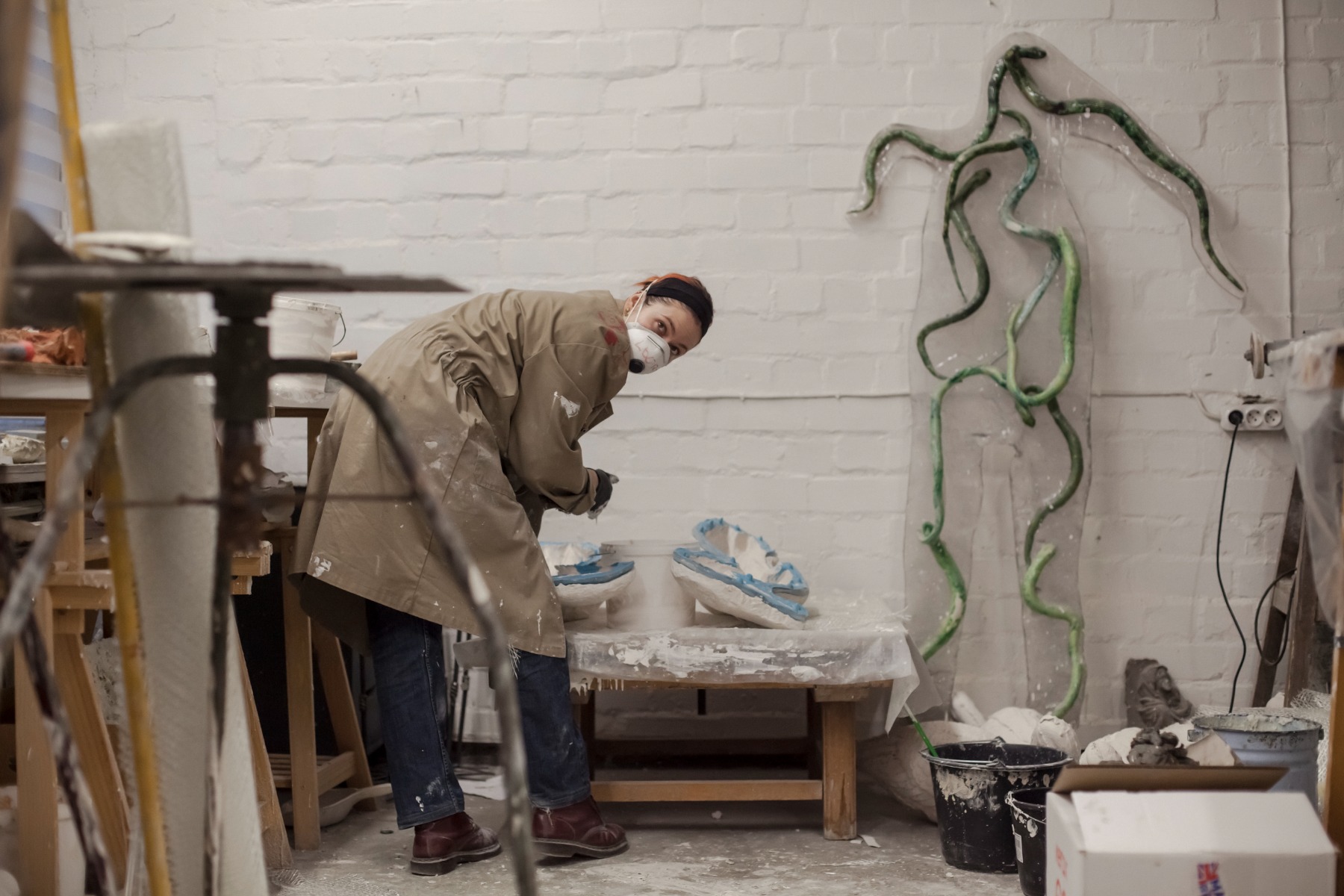
Edith Karlson studied installation and sculpture at the Estonian Academy of Arts (BA, 2006; MA, 2008). She has been awarded the EAA Young Artist’s Prize (2006) and the Köler Prize People’s Choice Award (2015). Karlson is among the recipients of the national artists’ salary in 2018–2020 and 2022–2024. In 2020 she received the Estonian Cultural Endowment’s main award.
Title image: Edith Karlson. Photo: Alana Proosa